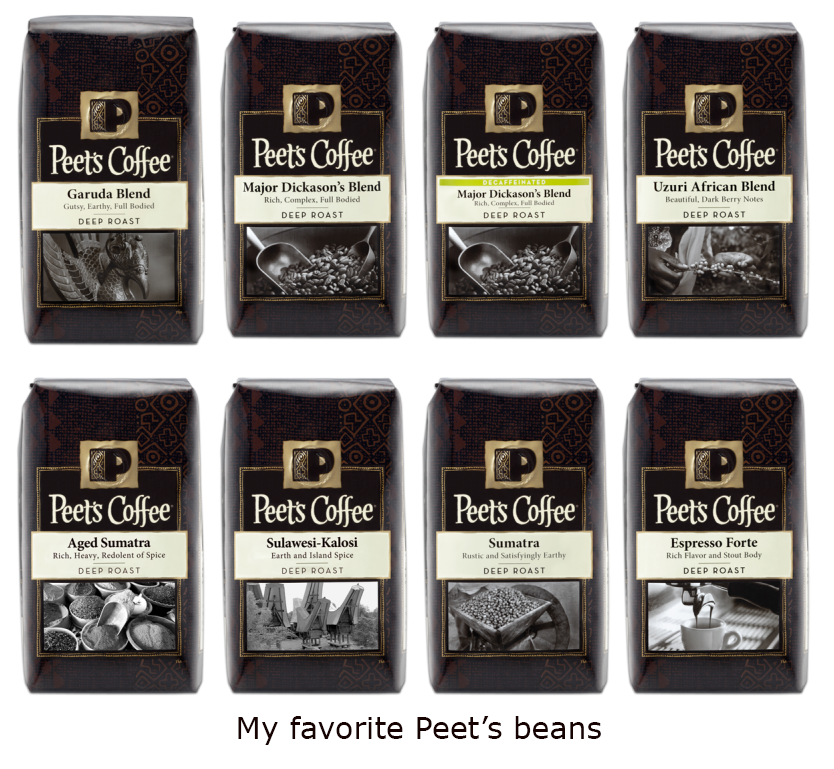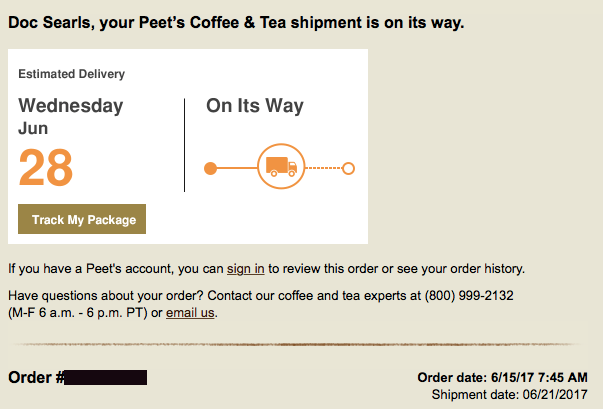
My loyalty to Peet’s Coffee is absolute. I have loved Peet’s since it was a single store in Berkeley. I told my wife in 2001 that I wouldn’t move anywhere outside the Bay Area unless there was a Peet’s nearby. That pre-qualified Santa Barbara, where we live now. When we travel to where Peets has retail stores, we buy bags of our favorite beans (which tend to be one of the above) to take to our New York apartment, because there are no Peets stores near there. When we’re in New York and not traveling, we look for stores that sell bags of one of the bean bags above.
Since our car died and we haven’t replaced it yet, we have also taken to ordering beans through Peet’s website. Alas, we’re done with that now. Here’s why:

I ordered those beans (Garuda and New Guinea) two Thursdays ago, June 16, at 7:45am. A couple days after I ordered the beans, I checked my account online to see where the shipment stood, and the site said the beans would be shipped on Monday, June 19. According to the email I got yesterday (a section of which I show above), the beans didn’t ship until the following Wednesday, June 21. Now the estimated delivery is next Wednesday, June 28.
While this isn’t a big deal, it’s still annoying because we just ran out of our last batch of beans here and we’ll be gone when that shipment arrives. Subscribing (which Peet’s e-commerce system would rather we do) also won’t work for us because we travel too much and don’t settle in any one place for very long. True, that’s not Peet’s problem, and I’m a sample of one. But I’ve experienced enough e-commerce to know that Peet’s shipping thing isn’t working very well.
And maybe it can’t. I don’t know. Here’s what I mean…
Way back in the late ’90s I was having lunch in San Francisco with Jamie Zawinski, whose work as a programmer is behind many of the graces we take for granted in the online world. (He’s a helluva writer too.) At one point he said something like “Somebody should figure out what Amazon does, bottle it, and sell it to every other retailer doing e-commerce.” And here we are, nearly two decades later, in a world where the one e-commerce company everybody knows will do what it says is still Amazon. (I’ll spare you my much worse tale of woe getting new air conditioners bought and shipped from Home Depot. I’m also not saying Amazon lacks moral failings. There are plenty of those, but all beside the point I’m making here.)
So that’s a problem on the service side.
Now let’s talk marketing. A while back, Peet’s came out with an app that lets you check in at its stores for rewards when you buy something there. You do that this way at the cash register:
- Find the app on your phone.
- Click on Check In, so a QR code materializes on your phone’s screen.
- Aim the QR code at a gizmo by the cash register that can read the QR code.
- Hope it works.
I’ve done this a lot, or at least tried to. Here are just some of the problems with it, all of which I offer both to help Peet’s and to dissuade companies everywhere from bothering with the same system:
- It doesn’t work at every Peet’s location. This is annoying to customers who break out their phone, bring up the app, get ready to check in, and then get told “It’s not here yet.”
- Workers at the stores don’t like it—either because it’s one more step in the ordering process or because, again, “it’s not here yet.” Some employees put a nice face on, but you can tell many employees consider it an unnecessary pain in the ass.
- The customer needs to check in at exactly the right point in the purchase, or it doesn’t count. Or at least that’s been my experience a time or two. Whatever the deal is, the narrow check-in time window risks bumming out both the customer and the person behind the counter.
- The customer reviews are bad, with good reason. On the app’s page in iTunes Preview it says, “Current Version: 17 Ratings (1.5 stars) All Versions: 94 Ratings (2 stars).” The only published 4-star review reads, “They are a little vague on the rewards system – do I get a point per visit, or a point per drink? Also not a very rewarding system, esp when compared to starbucks or non chains I know of. However, I’ve had no problems with the app malfunctioning, so although I dislike the system it’s not the apps fault.”
- It sometimes doesn’t work. I mean, bzzzt: no soap. Or worse, works poorly. For example, when I opened the app just now, it said “Hi, Peetnik” and told me I have 0/15 reward points, meaning I’ve checked in zero times. Then, when I clicked on the “>”, it said “15 more & your next cup’s on us.” Finally, when I fiddled with the app a bit, it woke up and told me “4 points until your next reward.”
Here’s the thing: None of this stuff is necessary. Worse, it’s pure overhead: a value-subtract from the start. And Peet’s is one of the all-too-rare retailers that doesn’t need this kind of crap at all. It has already earned, and keeps, the loyalty of its customers. It just needs to keep doing a better job of making better coffee.
In The Intention Economy I tell the story of Trader Joe’s, another retailer that does a good job of earning and keeping its customers’ loyalty. You know how they do that? With approximately no marketing at all. “We don’t do gimmicks,” Doug Rauch, the retired President of Trader Joe’s told me. No loyalty cards. No promotional pricing. No discounts for “members.” (In fact, they have no discounts at all. Just straightforward prices for everything.) Almost no advertising. Nothing that smacks of coercion. And customers love them.
My recommendation to Peet’s on the service side is to ship as fast and well as Amazon, or to stop trying and let Amazon handle the whole thing. Amazon already carries a variety of Peet’s beans and other coffee products. Either way, there is no excuse for taking almost two weeks to deliver an order of beans.
On the marketing side, I suggest dropping the app and the gizmos at the stores. Save the operational costs and reduce the cognitive overhead for both personnel and customers. Personal data gathered through apps is also a toxic asset for every company—and don’t let any marketers tell you otherwise. Like Trader Joe’s, Peet’s doesn’t need the data. Make the best coffee and provide the best service at the stores, and you’ll get and keep the best customers. Simple as that.
You’re in the coffee game, Peet’s. Keep winning that way. For everything that isn’t doing what you’ve always done best, less is more.
Leave a Reply